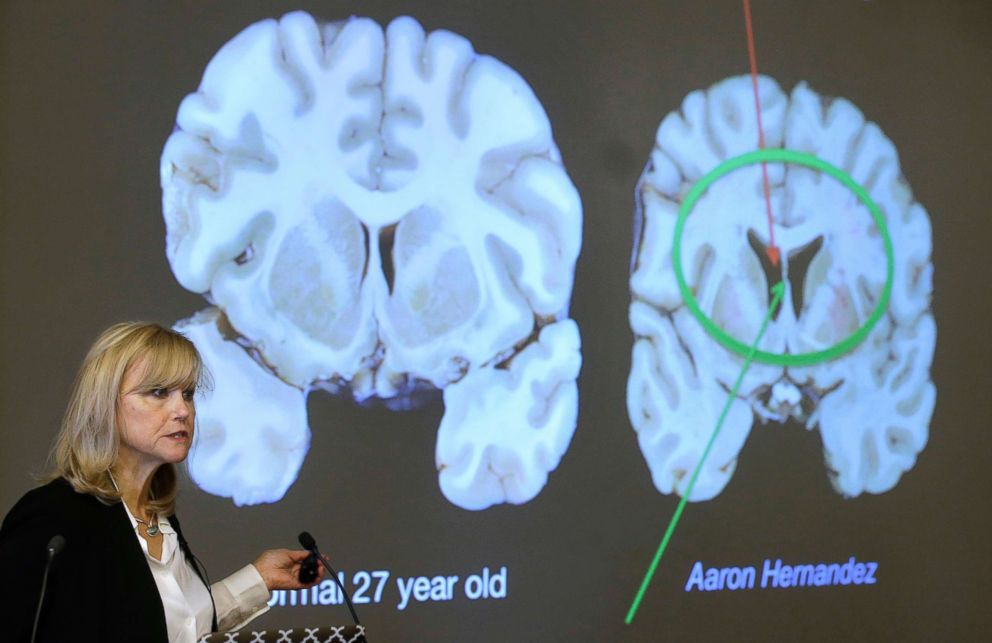Head trauma may be possible to diagnose with substances in the blood, study says
The study of NCAA football players found substances that could show head trauma.
American football players get hit hard, often in the head. But the effects of each impact are usually not as severe as a concussion –- they are "subconcussive impacts."
A new study, published in the Journal of Neurosurgery, followed 35 NCAA football athletes through the course of the 2016 football season and used simple blood tests to try detect brain damage resulting from subconcussive impacts, which don't usually cause symptoms. They especially looked for changes over time.
Head traumas like subconcussive impacts can lead to longer-term changes in the brain and may also contribute to neurodegenerative disorders such as chronic traumatic encephalopathy, or CTE.
Yet, there’s no current way to detect these changes. Most research has focused at looking at athletes’ brains after death, but this blood test is for living patients.
"Efforts to determine the effect of subconcussive impacts throughout an athlete's career may prove useful, especially if those efforts are feasible and cost effective,” said lead researcher Jonathan Oliver, a professor of kinesiology at Texas Christian University.

So the researchers at Texas Health Sports Medicine and the University of Wisconsin-La Crosse developed an easy-to-use diagnostic test and looked at the blood samples of the 35 athletes in the study, specifically searching for biomarkers, or biological substances in the blood that can indicate disease, in the brain that could indicate injury.
They were looking for two biomarkers –- tau proteins and neurofilament light polypeptide, called NF-L -- which can become elevated in the blood after even mild brain injury. These proteins help form parts of axons, the long projections from brain cells that transmit information and perform essential functions. Injury to the brain disrupts these axons, that’s why these proteins leak into the blood.
Oliver and his colleagues grouped the athletes into 20 starters and 15 nonstarters. Seven blood samples were collected on seven different days before, during, and after the season, testing for tau and NF-L levels.
They wanted to look at the fluctuations of blood concentration of tau and NF-L over the course of the season, during which hits to the head varied.
Tau is the first biomarker to appear after a concussion. It’s typically seen in the first 12 hours, but rarely after 72 hours. NF-L, which can be a sign of subconcussive head trauma, comes later and can remain in the blood for up to three weeks.
Though the two proteins did appear to change in the football players over the 2016 season, it wasn't exactly in the way researchers expected.
Surprisingly, Dr. Oliver found that Tau did “not seem to be elevated following subconcussive impacts, at least at the time points we measured, while NF-L seemed to remain elevated for some time.”
Tau levels decreased over the season, with lower values seen in starters. Surprisingly, they didn’t increase until the season was over. The stats showed tau concentration were not as useful in determining injury due to repeated subconcussive impacts.
In contrast, NF-L levels increased throughout the season, as the players had more hits to their head, especially in starters. In non-starters the levels didn’t fluctuate as much. The NF-L biomarker test fared well in showing which starters or nonstarters had multiple hits to the head.
Neuroimaging can be further used to see whether the changes in NF-L were due to an expected brain response from injury, the same way a bug bite causes a physical bump on the skin.
This study adds to the pool of knowledge about head trauma, and additional larger studies will need to be done to figure out what levels of NF-L are normal and what levels are elevated. The authors hope biomarkers will become a tool to monitor and help improve long-term brain health in athletes.
“With our current study we hope to have started a discussion about the potential utility of these biomarkers” in measuring the damage due to subconcussive impacts. “However, this work is only in its infancy,” notes Dr. Oliver.
The researchers hope biomarkers will one day be used as a tool, in conjunction with a sideline exam and imaging, to monitor and help improve long-term brain health in athletes.
Sima Patel, M.D., is a third-year physical medicine and rehabilitation resident at the University of Minnesota who works in the ABC News medical unit.




